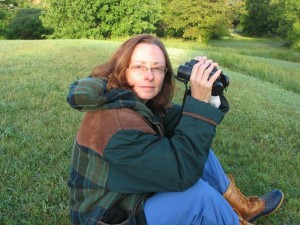Keep Warner Park Wild
One muggy summer Saturday, I sat along Warner Park Lagoon while Ghanian drummers pounded, Malian singers crooned, and dancers turned their pelvises into blenders.
 Surrounded by African-Madisonian women in shimmering gold, orange, turquoise, and lime green dresses, I could see both the stage acts and a young man at the water’s edge engrossed in a book.
Surrounded by African-Madisonian women in shimmering gold, orange, turquoise, and lime green dresses, I could see both the stage acts and a young man at the water’s edge engrossed in a book.
Barn swallows twittered and dive-bombed above him as Moroccan belly dancers rippled abdominal muscles in rolling waves of flesh.
As Africa Fest reached its finale, my husband and I biked home through the park. Just yards from dancers, hidden in the embrace of the park’s largest bicentennial bur oak, sat a tiny lichen-covered eastern wood pewee nest. I’d been watching the nest for 19 days.
The fuzzy brownish chick with the bright yellow beak was getting big, and I was worried. The nest was next to the bike path and dog park. If the nestling suddenly toppled out, he might become a dog treat.
That evening Junior Pewee was still there, six days old and hanging out of the nest like a kid on his first carousel ride. “Get back in there,” I yelled. The drums still beat behind us as we rode away. I said to my husband, “Where else in Madison could you see all this?”
We moved to Madison two years ago, and since then I’ve clocked 135 hours in Warner Park studying birds. We chose the North Side because of human diversity, but I never expected to find so much biodiversity. So far I’ve found over 85 species in Warner Park and shared morning coffee with a bald eagle, an ovenbird, a sora, and spent several cocktail hours watching two great horned owls court.
The biodiversity in just one dead tree – favorite bird perches – can be stunning. One morning on a marsh island tree, a young red-tailed hawk, two hummingbirds, several small yellow warblers, goldfinches, an eastern kingbird and blackbirds, all sat on different branches like ornaments in a Christmas tree.
Many Warner birds are long-distance migrators and are heading to winter homes in Latin America. Our pewee family may fly as far as Peru. Some of our hummingbirds may cross the Gulf of Mexico in one 18-hour night. They all face an increasingly dangerous journey because of cell towers, skyscrapers, pesticides, harsh weather, predators and disappearing habitat. Half may not make it back. But those that do will probably return to Warner Park.
The North Side has a new neighborhood plan that proposes changes to park habitat that could hurt birds. Our birds prefer the wilder parts of the park, where they can raise their families. They need the undisturbed marsh island, unmowed meadow and woods. On Wednesday, the Board of Comissioners will vote on this plan.
I ask the board to please protect Warner Park’s biodiversity for future generations. Our park is already too urbanized, paved and mowed. Let’s ensure our feathered neighbors have a home to return to in the spring.
Reprinted from Madison.com.
O’Kane is a Ph.D. student in environment and resources at the Gaylord Nelson Institute of UW-Madison. She researches birds that migrate between Madison and Central America.
You must be logged in to post a comment.